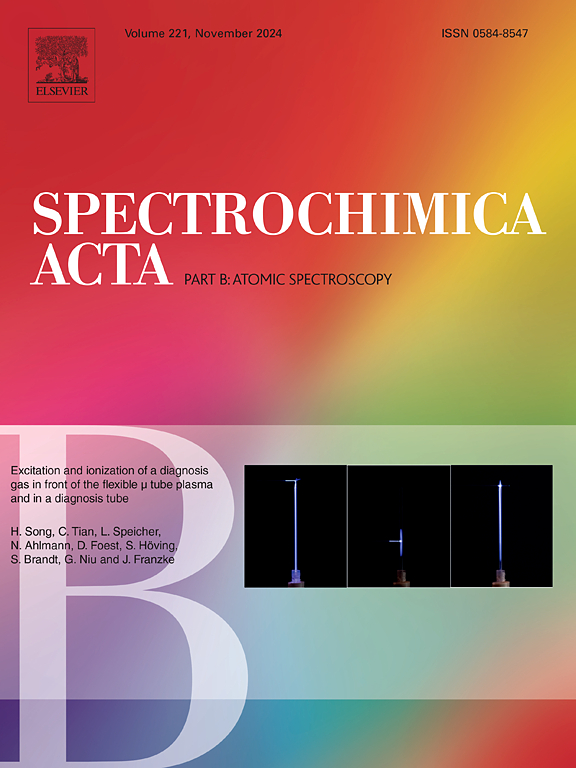Experimental transition probabilities and oscillator strengths of singly ionised Xenon (Xe II) in the ultraviolet. A fully statistical approach to the determination of uncertainties
IF 3.8
2区 化学
Q1 SPECTROSCOPY
引用次数: 0
Abstract
We report 92 experimental values of transition probabilities and oscillator strengths for singly ionised xenon (Xe II) in the ultraviolet region (217–385 nm), 91 of which have been measured for the first time. The transition probabilities were obtained from the analysis of spectra emitted by a plasma in partial local thermodynamic equilibrium (pLTE) generated in a pulsed-discharge lamp. The resolving power of our experimental setup is 120,000 at 380 nm. The novelty of this work lies in its use of an exponential fitting technique rather than the linear Boltzmann Plot method. We include a detailed, purely statistical analysis of the uncertainties of our new measurements, together with an in-depth explanation of our measurements to promote transparency and reproducibility. We have implemented this fully statistical approach to the calculation of the uncertainties in a code developed in our laboratory, which can be freely downloaded from our laboratory's Zenodo repository to support Open Science and help other atomic data producers to calculate the uncertainties of their measurements. The uncertainties of our new transition probabilities are smaller than 15 % for 11 % of the lines and 30 % for 87 % of the spectral lines.

单电离氙(Xe II)在紫外中的实验跃迁概率和振子强度。确定不确定性的完全统计方法
我们报道了92个单电离氙(Xe II)在紫外区(217-385 nm)的跃迁概率和振子强度的实验值,其中91个是首次测量的。通过对脉冲放电灯中产生的等离子体局部热力学平衡(pLTE)的光谱分析,得到了跃迁概率。我们的实验装置在380纳米处的分辨能力为120,000。这项工作的新颖之处在于它使用了指数拟合技术,而不是线性玻尔兹曼图方法。我们对新测量的不确定性进行了详细的、纯粹的统计分析,并对我们的测量进行了深入的解释,以提高透明度和可重复性。我们已经在我们实验室开发的代码中实现了这种完全统计的方法来计算不确定度,该代码可以从我们实验室的Zenodo存储库免费下载,以支持开放科学并帮助其他原子数据生产者计算其测量的不确定度。我们的新跃迁概率的不确定度对11%的谱线小于15%,对87%的谱线小于30%。
本文章由计算机程序翻译,如有差异,请以英文原文为准。
求助全文
约1分钟内获得全文
求助全文
来源期刊
CiteScore
6.10
自引率
12.10%
发文量
173
审稿时长
81 days
期刊介绍:
Spectrochimica Acta Part B: Atomic Spectroscopy, is intended for the rapid publication of both original work and reviews in the following fields:
Atomic Emission (AES), Atomic Absorption (AAS) and Atomic Fluorescence (AFS) spectroscopy;
Mass Spectrometry (MS) for inorganic analysis covering Spark Source (SS-MS), Inductively Coupled Plasma (ICP-MS), Glow Discharge (GD-MS), and Secondary Ion Mass Spectrometry (SIMS).
Laser induced atomic spectroscopy for inorganic analysis, including non-linear optical laser spectroscopy, covering Laser Enhanced Ionization (LEI), Laser Induced Fluorescence (LIF), Resonance Ionization Spectroscopy (RIS) and Resonance Ionization Mass Spectrometry (RIMS); Laser Induced Breakdown Spectroscopy (LIBS); Cavity Ringdown Spectroscopy (CRDS), Laser Ablation Inductively Coupled Plasma Atomic Emission Spectroscopy (LA-ICP-AES) and Laser Ablation Inductively Coupled Plasma Mass Spectrometry (LA-ICP-MS).
X-ray spectrometry, X-ray Optics and Microanalysis, including X-ray fluorescence spectrometry (XRF) and related techniques, in particular Total-reflection X-ray Fluorescence Spectrometry (TXRF), and Synchrotron Radiation-excited Total reflection XRF (SR-TXRF).
Manuscripts dealing with (i) fundamentals, (ii) methodology development, (iii)instrumentation, and (iv) applications, can be submitted for publication.

 求助内容:
求助内容: 应助结果提醒方式:
应助结果提醒方式:


